-
Key Persons
-
Important Agreements
-
Chronology of Events
-
 Infographics
Infographics
-
Key Agencies
-
Chronology of Visits
-
 News
News
-
 Monthly Review
Monthly Review
Abkhazian and South Ossetian involvement in Russia's military aggression against Ukraine
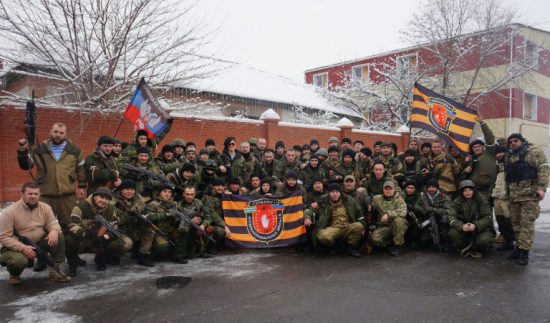
Author: Volodymyr Posviatenko
Notes:
- The definition ‘Abkhazia’, for the purpose of this text, means both the region of Abkhazia, administratively belonging to the Autonomous Republic of Abkhazia, as well as the so-called ‘Republic of Abkhazia’ as a form of the Russian occupation of the Autonomous Republic of Abkhazia.
- The definition ‘“South Ossetia”’, for the purpose of this text, means the so-called ‘Republic of South Ossetia’ as a form of the Russian occupation of the Tskhinvali region, comprising parts of Shida Kartli, Imereti, Racha-Lechkhumi-Kvemo Svaneti, and Mtskheta-Mtianeti regions of Georgia. To refer to actions of de-facto authorities and quasi-official structures of the Tskhinvali region, the terms ‘“South Ossetia”’ and ‘South Ossetian’ are used. To refer to the territory itself, the term ‘the Tskhinvali region’ is used.
- The definition ‘ORDLO’ is the term commonly used in Ukraine to indicate the temporarily occupied parts of Donetsk and Luhansk Oblasts from 2014 until the full-scale invasion of 2022.
- The definition ‘temporarily occupied territories of Ukraine’ is the official term in Ukraine to indicate Russian-occupied territories of Ukraine since 18 July 2022.
- Russia claims parts of Mykolaiv Oblast, which it was temporarily occupying at the time of the illegal referendums in September 2022, namely, the former Snihurivka District and the Kinburn Peninsula, as part of Kherson Oblast, which Russia declared it had formally annexed.
Georgia and Ukraine are traditionally considered to be close allies and strategic partners. After regaining their independence in 1991, the countries have built affinity based on common values, a strong sense of national self-determination, European and Euro-Atlantic aspirations, and geopolitical ties. Crucially, an important factor for the closeness between the states is the resistance against the common enemy. Both Ukraine and Georgia have a shared problem – Russia is occupying parts of their territory.
The root causes of the Russian-Georgian and the Russian-Ukrainian wars and Russian policies of occupation vary from case to case. However, Russia’s main goals in Ukraine and Georgia are the same – impede the states’ European and Euro-Atlantic integration and create conditions for regaining control over them in one way or another. In this regard, Russia used a similar strategy – it ignited separatist conflicts within the independent states, while simultaneously covertly providing military assistance to gain control over the so-called “separatist regions”. Consequently, the countries’ future is tied to the resolution of the conflicts which Russia is interested to maintain, effectively occupying the regions militarily.
In Georgia, Russia exerts military occupation over Abkhazia as the so-called “Republic of Abkhazia” and the Tskhinvali region as the so-called “Republic of South Ossetia”. Russia recognised both illegal entities as independent states in 2008, after the August War. When Russia occupied Crimea in 2014, many Georgian political experts stated that the insufficient reaction of the West to the Russian war against Georgia had led to this situation. Similarly, the insufficient reaction to the occupation of Crimea and parts of the Donbas emboldened Russia and led to further escalation, culminating in the full-scale Russian invasion of Ukraine in 2022.
In Ukraine, as of 4 July 2023, there are several Russian-occupied territories. In 2014, Russia occupied Crimea, comprising the Autonomous Republic of Crimea and the City of Sevastopol, which is currently militarily controlled by Russia in its entirety. Crimea became the first territory of a post-Soviet country that Russia claims it has formally annexed as part of the Russian Federation. Moreover, in 2014, Russia fomented the creation of the so-called “Donetsk People’s Republic” (“DPR”) and “Luhansk People’s Republic” (“LPR”) in the Eastern region of the Donbas, and occupied parts of Donetsk and Luhansk Oblasts (Окремі райони Донецької та Луганської областей (ОРДЛО) – ORDLO). The same year these formations were proclaimed as republics, while Ukraine recognised them as terrorist organisations.
On 22 February 2022, Russia recognised the so-called “DPR” and “LPR” as independent states and commenced its full-scale invasion shortly after. Since then, Russia managed to temporarily occupy more territory of Donetsk Oblast, almost full territory of Luhansk Oblast, significant parts of Kherson and Zaporizhzhia Oblasts, as well as small parts of Kharkiv and Mykolaiv Oblasts. Together, all the abovementioned areas are known as the temporarily occupied territories (TOT) of Ukraine. Moreover, in October 2022, despite not controlling any of the regions fully, Russia declared formal annexation of the entirety of Donetsk, Luhansk, Zaporizhzhia, and Kherson Oblasts, together with several districts of Mykolaiv Oblast.
When Russia commenced its war of aggression against Ukraine in 2014, occupying Crimea and parts of the Donbas, Abkhazia and “South Ossetia” came to Russia’s help. After Russia declared the formal annexation of Crimea, Abkhazia and “South Ossetia” embraced this action and issued statements in support. However, Abkhazian and South Ossetian policies of recognition of the “DPR” and the “LPR” are remarkably different. “South Ossetia” recognised both formations as independent states in 2014. Interestingly, the “LPR” was recognised earlier, on 18 June 2014, while the “DPR” was recognised on 27 June 2014. In the period between 2014 and 2022, “South Ossetia” built political and economic ties with the illegal entities of the Donbas and helped Russia to evade international sanctions by acting as a formal intermediary in economic relations between Russia and the ORDLO. On the other hand, Abkhazia delayed recognition until 25 February 2022, doing so only after Russia itself recognised “DPR” and “LPR”. Cooperation between Abkhazia and the ORDLO was limited to mostly rhetorical support for the illegal entities’ “self-determination”.
Nevertheless, both Abkhazians and Ossetians from the Tskhinvali region can “boast” contributions to Russia’s military effort in Ukraine. The illegal entities’ inhabitants’ participation in the Russian aggression against Ukraine spans back to the Russian invasion of the Donbas in 2014. Their active involvement in the TOT of Ukraine only increased after Russia started its full-scale invasion.
The following analysis provides a thorough review of Abkhazia’s and South Ossetia’s military involvement in Russia’s temporary occupation of Ukraine’s territories and facilitates the identification of war criminals from the temporarily occupied territories of Georgia. Analysing Abkhazian and South Ossetian involvement in Russia’s military effort in Ukraine is crucial to evaluate the role which representatives of Abkhazia and “South Ossetia” have played in the facilitation of the Russian aggression and the motivations behind their participation in it.
Abkhazian and South Ossetian military involvement in the temporarily occupied parts of the Donbas between 2014 and 2022
Abkhazians in the Donbas: the “Pyatnashka” brigade

The “Pyatnashka” brigade leadership
The most notorious military unit with an Abkhazian presence fighting for Russia in Ukraine is the so-called “Pyatnashka” international brigade. “Pyatnashka” is an illegal armed group, part of the 100th motorised rifle brigade of the 1st Army Corps of the “DPR”, officially part of the Armed Forces of the Russian Federation since 2022. “Pyatnashka” was formed primarily by ethnic Abkhazians and other inhabitants of Abkhazia. In 2014-2015, “Pyatnashka” took part in various battles, such as the battles of Maryinka, Debaltseve, Shakhtarsk, Savur-Mohyla, Ilovaisk, and Donetsk airport. Since 2016, “Pyatnashka” took part in fights mostly in the Avdiivka direction.
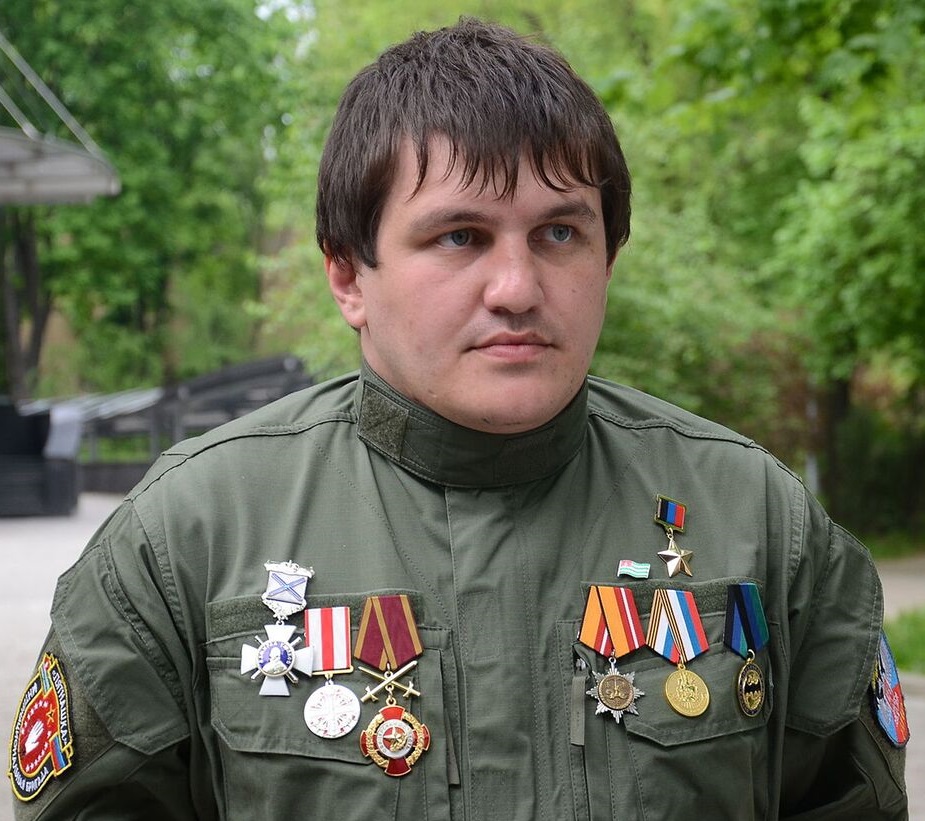
Akhra Avidzba
“Pyatnashka”’s first leader and founder is Akhra Avidzba, nicknamed “Abkhaz”. During the period of his participation in the Russian invasion of the Donbas, Avidzba was exceedingly active in the media, becoming a hero of Russian propaganda and receiving the “Hero of the DPR” medal from the de-facto leader of the “DPR” Aleksandr Zakharchenko. Avidzba fought for Russia from the initial stages of the Russian-Ukrainian war, arriving in the Donbas in the summer of 2014. Allegedly, he assembled fifteen mercenaries, who nicknamed the brigade alluding to the number of members (in Russian, “pyatnadtsat’” – “fifteen”).

The “Pyatnashka” brigade insignia
The insignia of “Pyatnashka” displays the flags of the “Republic of Abkhazia” and the “DPR”, as well as the open right hand on the red background, as seen on the flag of the self-proclaimed republic, in the middle. The insignia also includes fifteen stars, representing the number of mercenaries.
In 2014-2015, the deputy commander of the brigade was Stavros Bagatelia, also from Abkhazia, who lived in Donetsk since 2012. In April 2015, Bagatelia was also appointed by Zakharchenko to oversee the seized ATB retail chain, which the occupants renamed the “First Republican Supermarket”. Later, he left “Pyatnashka” and became a deputy commander of the so-called “Republican Guard” of the “DPR”. Avidzba and Bagatelia were awarded the Order of Courage of the “Republic of Abkhazia” by then de-facto president Raul Khadzimba.

The “Pyatnashka” brigade in the Donbas
The list of the initial members also included Astamur Avidzba, Matbey Abidzhba, Akop Abromyan, Guram Bagatelia, Mikhail Zakhartsev, Besik Lipartia, Dmitriy Pogosov, Remzik Sarsania, Suram Skveria, Azamat Tvanba, Aleksandr Tvanba, and Garik Khalaydzhyan, as well as Irakli Adleiba, liquidated in 2015. Akhra Avidzba and the abovementioned mercenaries were awarded the badge “Dobrovolets Donbassa”, together with Daniil Bigbava, who did not participate in military actions but popularised the “Pyatnashka” brigade on the internet. Other Abkhazian natives confirmed to have fought for “Pyatnashka” in 2014-2015 include Vladimir Gurzulidi and Temo Uchava.
Avidzba and his “Pyatnashka” brigade are infamously known for their engagement in car thefts in Russia-occupied parts of the Donbas. According to an Espresso article, “Pyatnashka” was engaged in the following scheme: armed militants performed a forceful seizure of a car to transport it to Russia for sale; after that “luxury” cars were given duplicate number plates from Deo and even Zhiguli and later sold several times cheaper. In July 2014, in a Facebook post, Avidzba boasted about cars stolen from PrivatBank.
In October 2016, Ukrainian journalist Roman Donik claimed that Avidzba was involved in the murder of Arsen Pavlov, nicknamed “Motorola” – a citizen of Russia, one of the most notorious field commanders known for murdering and torturing Ukrainian POWs, who led the so-called “Sparta” battalion. Donik claimed that Motorola was killed by “Abkhaz’s people” or his wife's apparent misbehaviour in Abkhazia, where she allegedly offended Abkhazia and Abkhazians. According to his sources, Stavros Bagatelia financed the murder. At the end of 2016, Avidzba left the TOT of Ukraine in unknown circumstances.
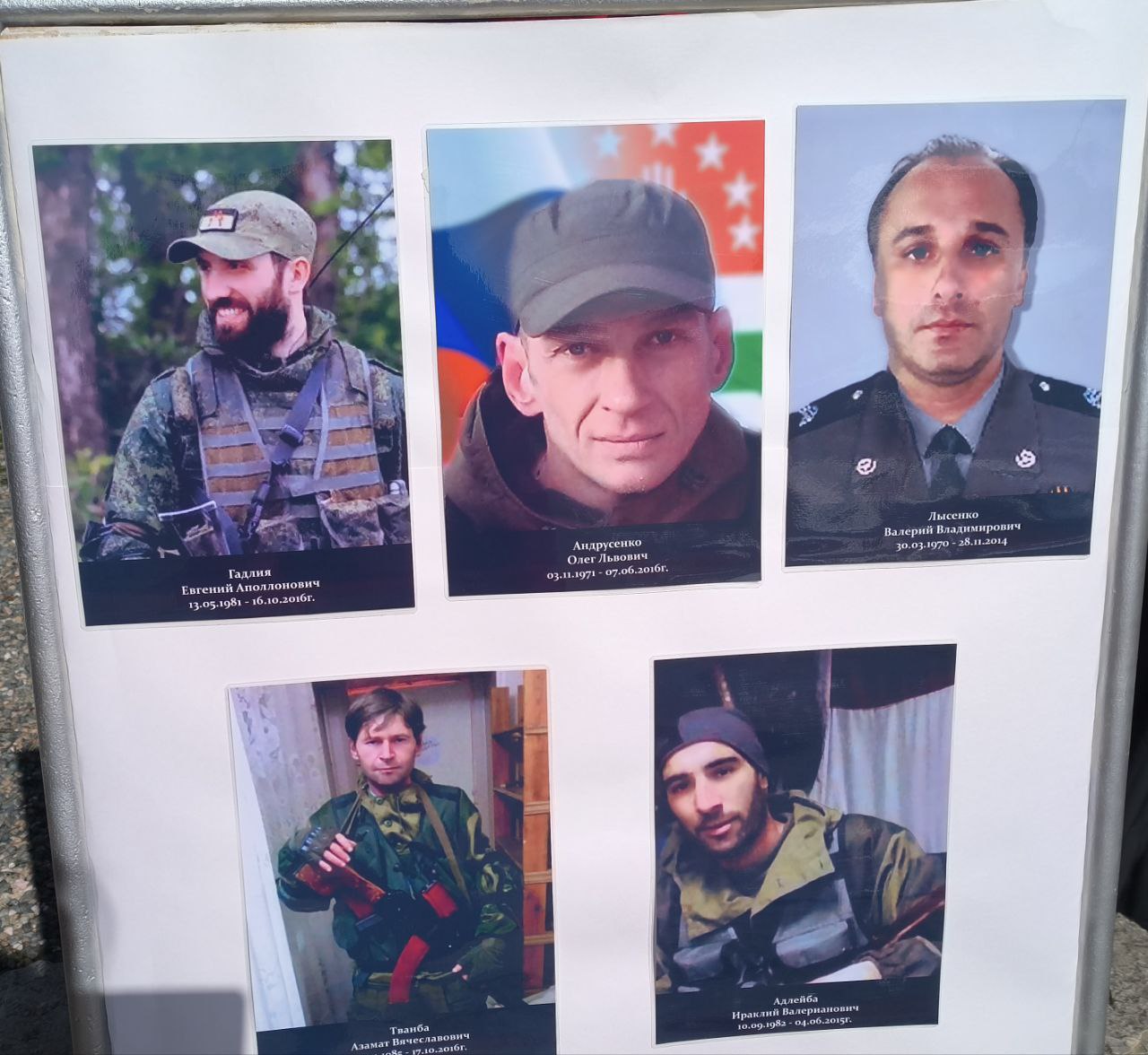
Abkhazian mercenaries, who died in the Donbas between 2014 and 2016
On 6 February 2023, mercenaries from Abkhazia participating in the Russian invasion of the Donbas, who died between 2014 and 2016, were awarded the “Order of Courage and Valour” by order of the de-facto president of Abkhazia Aslan Bzhania. The following mercenaries were reported to had died: Irakli Adleiba on 4 June 2015, Oleg Andrusenko on 7 June 2016, Evgeniy Gadlia on 16 October 2016, Valeriy Lysenko on 28 November 2014, and Azamat Tvanba on 17 October 2016.
South Ossetians in the Donbas: Anatoliy Bibilov’s activities
Mercenaries from “South Ossetia” also assisted Russian occupation forces in the initial stage of the Russian-Ukrainian war. Ossetians from the Tskhinvali region, together with Ossetians from North Ossetia, primarily fought for the so-called “Vostok” battalion of the “DPR”, which at that time was led by Aleksandr Khodakovskiy, the first so-called “minister of state security” of the “DPR”. In the summer of 2014, Ossetians who participated in the Russian intervention in the Tskhinvali region of Georgia in August 2008 were allegedly the backbone of the battalion.
In October 2014, it was reported that forty mercenaries returned from Donbas to the Tskhinvali region. On 10 December 2014, de-facto president Leonid Tibilov urged South Ossetian mercenaries to return to the Tskhinvali region, saying that their “task came to an end” since “the active phase of the conflict was over”. On 12 December 2014, North Ossetian mercenary Alan Mamiev announced that ethnic Ossetian mercenaries from the “Vostok” battalion were leaving Donbas, further claiming that “only a few decided to stay in Donetsk”.
In 2016, Akhra Avidzba was replaced as a commander of “Pyatnashka” by Oleg Mamiev, nicknamed “Mamay” – a native of North Ossetia, who took part in the Russian occupation of the Tskhinvali region in 2008 and previously fought in the “Vostok” battalion. In that period, the Ossetian influence in the brigade had grown and many South Ossetian mercenaries joined “Pyatnashka”.
In April 2017, the post of de-facto president of “South Ossetia” was assumed by Anatoliy Bibilov. The new de-facto president became exceptionally active in terms of military support to the Russian occupation of the ORDLO. Even before coming to power, Bibilov was a strong lobbyist of cooperation with the illegal entities of the Donbas. In September 2015, he was included in Ukraine's sanctions list, due to repeated visits to the temporarily occupied ORDLO and Crimea.
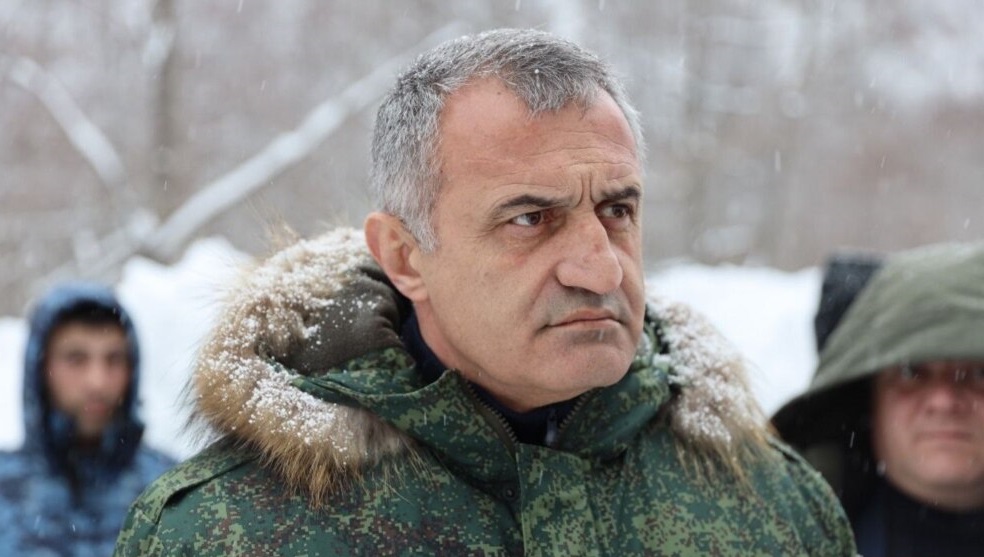
Anatoliy Bibilov
Bibilov visited the TOT of Ukraine on numerous occasions, sometimes multiple times per year. In January 2018, Bibilov visited temporarily occupied Donetsk, where he allegedly visited positions of the “Pyatnashka” brigade and attended a training exercise at a landfill. Bibilov allegedly provided sets of winter uniforms to mercenaries and met with the then-commander of the brigade Mamiev. Moreover, Bibilov promised to strengthen coordination in the politico-military sphere between the quasi-republics of “South Ossetia”, Abkhazia, the “DPR”, and the “LPR”. On 9 May 2018, the South Ossetian de-facto army took part in a military parade in temporarily occupied Donetsk. On 17 May 2018, the-then commander of “Pyatnashka” Oleg Mamiev was liquidated near Avdiivka. Bibilov took part in Mamiev’s farewell ceremony held in Vladikavkaz and mourned the mercenary’s death. In September 2021, Bibilov attended a military ceremony in temporarily occupied Donetsk and claimed that “[…] there is a spirit […] which unites and empowers us all, regardless of nationality and religion. And that is the Russian spirit. […] The Russian world, for which we are fighting. And in this sense, each of us is Russian”. Undoubtedly, by actively supporting Russia’s military occupation regime in the ORDLO, Bibilov wanted to present himself as a reliable ally of Russia.
Abkhazian and South Ossetian participation in the full-scale Russian invasion of Ukraine
Motivations and justifications
At the time of the full-scale Russian invasion of Ukraine, Abkhazia and “South Ossetia” have only increased their participation in Russia’s aggression. The de-facto leaders of the illegal entities issued supportive statements to both Russia’s recognition of the “DPR” and the “LPR” and the full-scale Russian invasion.
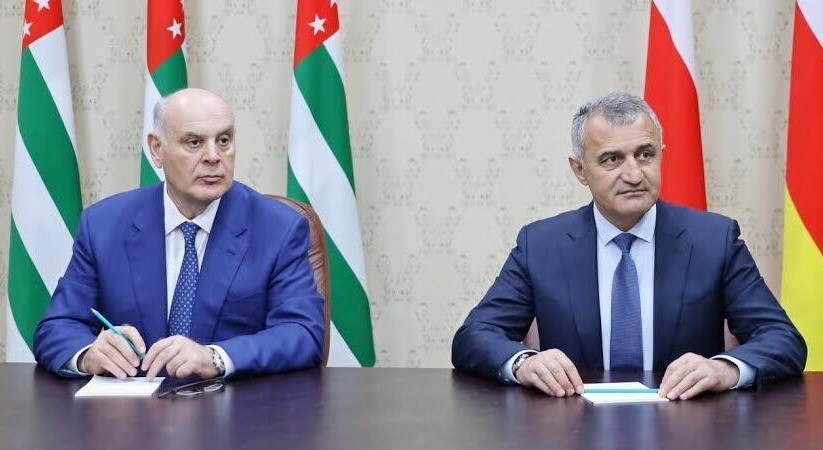
Aslan Bzhania and Anatoliy Bibilov
The de-facto president of Abkhazia Aslan Bzhania stated that the decision to recognise the occupation entities of the Donbas “will contribute to strengthening the security architecture in the region” and “promotes a more just and balanced world order where the rights of small peoples are well protected”. On 11 March 2022, in Sokhumi, at the rally in support of Russia's war of aggression, organised by the occupation authorities of Abkhazia, Bzhania claimed that Abkhazians should support Russia because “Measures taken by the Russian leadership […] are aimed at eliminating strategic threats, both to Russia itself and its real friends, and above all to [Abkhazia]”.
In the Tskhinvali region, a similar rally was held on 2 March 2022. The then de-facto president Anatoliy Bibilov and other speakers, parroting Russian propaganda narratives, claimed that Ossetians from the Tskhinvali region should support Russia because they “have themselves experienced the tragedy of the politics of nationalism and fascism” and thus they should offer “unconditional support” to Russia in appreciation for “saving” them. The current de-facto president of “South Ossetia” Alan Gagloev expressed the position in support of the Russian aggression in his address to the de-facto parliament of “South Ossetia” on 29 May 2023. He stated that “[…] historical events unfolding today will shape the contours of the future for most nations in Europe and Asia. [Therefore] Our main ally is and will remain the Russian Federation. We see aggression against Russia as aggression against South Ossetia”, adding that Ossetians from the Tskhinvali region “stand side by side with the Russian soldier to defend common interests in this battle with Ukrainian neo-Nazism, which has become a puppet in the hands of the collective West.”
In conclusion, such statements from the de-facto leaders of the occupation authorities confirm that the general motivation for Abkhazian and South Ossetian participation in Russia’s aggression is the belief that the future of the “independence” of the illegal entities largely depends on Russia’s success in its military endeavour. Hence, Abkhazian and South Ossetian de-facto officials are trying to demonstrate their maximum support to Russia in order to seem reliable allies.
The initial stage of the full-scale invasion
On 12 March 2022, the General Staff of the Armed Forces of Ukraine (AFU) in its communique mentioned for the first time that Russia was bringing mercenaries from Abkhazia and the Tskhinvali Region, citing “heavy combat losses of personnel and problems with the recruitment of reserve units” as a reason. On 16 March 2022, reports emerged that units of Russia’s 4th military base in the temporarily occupied Tskhinvali region had departed to participate in the Russian full-scale war in Ukraine. Allegedly, the de-facto president of “South Ossetia” Anatoliy Bibilov was blamed on social networks for sending contract servicemen to Ukraine. According to the military deal with Moscow, signed in 2017, parts of the South Ossetian de-facto army were integrated into Russia’s 4th military base in the Tskhinvali region, while the number of its remaining forces is agreed upon with Russia. It was Bibilov who decided to reduce the size of the South Ossetian de-facto army and merge it with Russia’s 4th military base while promising that locals would remain in the Tskhinvali region. On 20 March 2022, Bibilov confirmed the rumours, saying “I am not the one who gave the order to the 4th military base because it is the Russian army, but […] when our friend is in trouble, we will stand side by side and fight shoulder to shoulder”.
On 25 March 2022, Washington Post reported that the Pentagon stated that “[They] have indications that [Russians] are drawing on forces from Georgia”, meaning “Russian troops that are based in Georgia”. On 26 March 2022, new reports of more South Ossetian servicemen leaving to participate in Russia’s aggression against Ukraine emerged. On 27 March 2022, Abkhazia’s de-facto defence minister Vladimir Anua pledged to provide military assistance to Russia “in line with allied commitments and presidential decision”.
On 30 March 2022, the General Staff of the AFU said that Russia had deployed about two thousand troops to Ukraine from the occupied territories of Georgia. The statement reads: “In order to man up the armed forces of the russian federation [sic], units of the 4th (the Tskhinvali region, South Ossetia) and 7th (Abkhazia) military bases, which are part of the Southern Military District, were transferred from the occupied territories of Georgia to the territory of Ukraine. From the 4th military base, three BTGs with a total strength of up to 1,200 Russian and Ossetian servicemen were formed and sent to Ukraine. Two BTGs were formed from the units of the 7th military base, which is around 800 people”. On 31 March 2022, Operational Command “East” of the Ukrainian Ground Forces reported killing “representatives of units from the 7th military base deployed on the territory of the self-proclaimed Republic of Abkhazia”.
The South Ossetian retreat
At the end of March 2022, a peculiar situation occurred with South Ossetian servicemen, when a number of them unexpectedly returned to the Tskhinvali region, reportedly after refusing to fight. On 30 March 2022, the Strategic Communications Directorate of the AFU reported that almost all personnel of one battalion tactical group from the 4th military base had refused to participate in combat. The same day, in the footage disseminated on Telegram, a dozen troops could be seen travelling on foot at the North Ossetian/Russian side of the Roki Tunnel, the sole crossing point into the temporarily occupied Tskhinvali region. Blogger Alik Puhati, an ethnic Ossetian native to the Tskhinvali region, wrote on Twitter that around three hundred soldiers of Russia’s 4th military base had returned “of their own free will”.
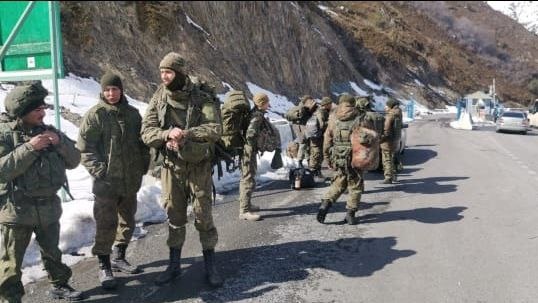
South Ossetian servicemen retreating to the Tskhinvali region
This puzzling retreat of South Ossetian servicemen provoked a scandal in the quasi-republic. Prior to the information becoming public, on 23 March, the former de-facto president of “South Ossetia” Eduard Kokoity lashed out at Anatoliy Bibilov, writing on his Telegram channel that “The attitude of the authorities towards our soldiers shocked all Ossetian people”. On 30 March, Kokoity said that “no one has the right to condemn these guys or accuse them of cowardice”. Later, Ruslan Totrov, a columnist from North Ossetia, slammed Bibilov for forcefully merging the South Ossetian de-facto army with the Russian Armed Forces. He expanded on the situation, writing that allegedly “Ossetians were expected to carelessly attack well defended Ukrainian positions in the kamikaze style, without any well thought thru strategy”. According to Totrov, it led to several incidents between Ossetians and Russian commanders, when the latter refused to supply the former with ammunition. In the end, Ossetians refused to obey orders and returned to the Tskhinvali region. According to the AFU StratCom, the RF authorities tried to criminally persecute refuseniks but were forced to limit themselves to disciplinary sanctions in cases of mass disobedience. Allegedly, the reason for this was the fear of spreading the information about the real mood in the troops and riots in military units.
The retreat scandal occurred in the middle of the de-facto presidential elections campaign in “South Ossetia”. In the aftermath of the scandal, on 2 April 2022, the then de-facto president of Anatoliy Bibilov paid a visit to the temporarily occupied parts of the Donbas, where he visited temporarily occupied Mariupol and planned to meet with mercenaries from the Tskhinvali region. Bibilov's endeavours in the Donbas, upon which he predominantly constructed his campaign, proved futile as they failed to secure his victory in the illegal elections held on 8 May 2022, resulting in his loss to Alan Gagloev.
“Partial mobilisation” in Abkhazia and the Tskhinvali region
When the decree on the “partial mobilisation” of Russian citizens was signed in September 2022, in a curious development, Abkhazia and “South Ossetia” rejected their participation in it. Initially, Russian authorities gave signals that Abkhazia is subject to mobilisation. However, despite Abkhazia’s public support of the Russian aggression and the fact that almost all its inhabitants are Russian citizens, the announcement of mobilisation was met with vocal discontent. After public rejection, despite previously giving mixed signals, the Abkhazian de-facto authorities unequivocally refused to participate in the mobilisation. Later, Russian officials clarified that the “partial mobilization” only applied to those Russian citizens who were registered in the officially recognised territory of the RF.
The de-facto Ministry of Defence of “South Ossetia” also denied that mobilisation was to be carried out in the quasi-republic. According to Paata Zakareishvili, the former Georgian state minister for reconciliation and civil equality, the authorities of North Ossetia did not allow Ossetians from the Tskhinvali region registered in Russia to return to the Tskhinvali region, as they were dissatisfied with the fact that Ossetians from the Tskhinvali region “could hide in formally ‘independent’ South Ossetia”. At the same time, Russia did not prevent Abkhazians registered in Russia from returning to Abkhazia.
Developments on the Zaporizhzhia front in 2023
The presence of ethnic Ossetian “Shtorm.Osetia” and “Alania” battalions is frequently reported in temporarily occupied parts of Zaporizhzhia Oblast. The battalions are comprised of ethnic Ossetian mercenaries from both North Ossetia and the Tskhinvali region. The Ossetian battalions reportedly suffered heavy losses in 2022.
When Ukraine started its counteroffensive operations on the Zaporizhzhia front in June 2023, the Ossetian battalions found themselves in the epicentre of military action. Most notably, the Ossetian presence was reported during the liberation of Lobkove and Piatykhatky in the vicinity of Vasylivka. On 18 June 2023, a Russian Telegram channel reported the death of Ayvengo Tekhov, a deputy commander of the “Shtorm.Osetia” battalion. In a Telegram post, it was stated that the whole of Tekhov’s unit was surrounded in Piatykhatky, and as a result “the whole battalion died”. On 19 June 2023, the “Shtorm.Osetia” battalion released a video on their Telegram channel, claiming the previous message was disinformation but confirming the death of “a couple” of mercenaries with Ayvengo Tekhov among them. Only sixteen mercenaries were present in the video, while it was previously reported that the battalion had more than 300 mercenaries. The real number of casualties remains unclear. On the same day, a video confirmation of the liberation of Piatykhatky was released by the AFU.

“Shtorm.Osetia” after escaping Piatykhatky
South Ossetian casualties
According to publications of various Ossetian Telegram channels and news media resources, 32 Ossetians native to the Tskhinvali region were reported to have been killed during the full-scale Russian invasion. The first death of a native of the Tskhinvali region, Andrei Bakaev, who served in the 58th Russian Army, was reported on 15 March 2022. On 1 April 2022, the death of a mercenary from “Pyatnashka” Robert Kulumbegov, who was also an Honoured Artist of “South Ossetia” and Abkhazia, was confirmed by de-facto authorities of the quasi-republic. Since then, the following death reports were published: Radislav Khugaev on 13 April 2022, Ruslan Besaev on 17 April 2022, Ruslan Kaziev on 18 April 2022, Inal Kortiev on 23 April 2022, Alim Lokhov on 4 May 2022, Alan Tedeev on 7 May 2022, Atsamaz Dzhioev and Atsamaz Bestaev on 18 May 2022, Roland Tskhovrebov and Alan Bagaev on 28 May 2022, Oleg Alborov and Alan Dudaev on 2 June 2022, Remik Kadzhaev on 2 June 2022, Vladimir Kozaev and Marat Dzhioev on 21 June 2022, Georgiy Koraev on 8 July 2022, Ruslan Zasseev on 16 September 2022, Albert Dzhussoev on 9 October 2022, Enver Dryaev on 29 October 2022, Ibragim Bagaev on 9 November 2022, Ivan Yelbakiev on 16 November 2022, Soslan Bagaev on 11 December 2022, Oleg Dzarakhokhov on 13 December 2022, Tamerlan Ostaev on 11 January 2023, Alan Dzhioev on 10 February 2023, Alan Gabatov on 12 February 2023, Genrikh Kasaev on 3 June 2023, Atsamaz Slanov on 12 June 2023, Alan Bitiev on 13 June 2023, and Ayvengo Tekhov on 17 June 2023.
The personality of Oleg Dzarakhokhov is peculiar. He was a criminal convicted to 19 years in prison for several murders, gang violence and the organisation of a criminal association. In 2022, he was hired as a mercenary for the Wagner Group. Dzarakhokhov was nominated for the Medal of Valour posthumously.
Several natives of the Tskhinvali region were reported to receive awards for their participation in the Russian aggression: Alan Fedorov (Dzhagaev), Aleksandr Bestaev, Aleksandr Khubulov, Arkadiy Sanakoev, David Mardanov, Dmitriy Dudaev, Erik Karkusov, Erik Sagkaev, Igor Bestaev, Ivan Chekhoev, Leonard Khugaev, Marat Bestaev, Ruslan Gabaraev, Sarmat Zasseev, Soslan Dzigoev, Soslan Parastaev, Soslan Tedeev, Spartak Pukhaev, Spartak Zoziev, Tamerlan Magkoev, Valeriy Bitarov, and Valik Gudiev.
The Abkhazian participation in the full-scale Russian invasion
Even prior to the full-scale invasion, on 20 February 2022, the de-facto president of Abkhazia Aslan Bzhania pledged readiness to provide military aid to the occupation authorities of parts of the Donbas. However, after the start of the full-scale Russian invasion of Ukraine, Abkhazia has not sent a single quasi-official military unit to Ukraine. Abkhazian military involvement is rather limited in comparison to South Ossetian.
Most of Abkhazia’s inhabitants participating in the Russian aggression are part of the “Pyatnashka” brigade. “Pyatnashka” is quite active on social media. The eponymous Telegram channel was created on 14 April 2022. The channel is regularly updated, providing extensive information about mercenaries’ actions, and allowing the identification of war criminals. Akhra Avidzba, who returned to the temporarily occupied part of Donetsk Oblast and has allegedly participated in military actions, is anew presented as a commander of “Pyatnashka”. In the spring of 2022, “Pyatnashka” was redeployed to the Avdiivka direction again. Russian forces have unsuccessfully been trying to capture the town of Avdiivka since July 2014.
On 22 August 2022, the Joint Forces Task Force of Ukraine reported hitting a location of an alleged “Pyatnashka” brigade base with a concentration of personnel and equipment, situated on the outskirts of temporarily occupied Donetsk. Detonation of ammunition in the alleged site was reported that day by local residents on social networks.

A reported strike on the alleged “Pyatnashka” brigade base
Abkhazian casualties
Reports about liquidations of Abkhazian natives during the full-scale Russian invasion are less frequent than those of Ossetians from the Tskhinvali region. Abkhazian deaths are likely harder to confirm due to the fact that Abkhazian natives participate in the Russian aggression mostly as mercenaries, while Ossetian servicemen from the Tskhinvali region are integrated into Russia’s 4th military base in the temporarily occupied territory.
Akhra Kirkinadze was the first Abkhazian whose death was confirmed by de-facto authorities of the quasi-republic on 1 April 2022. He was a mercenary for the “Pyatnashka” brigade and died in March 2022. Since then, the following death reports were published on the Telegram channel of “Pyatnashka”: Loran Smyr on 22 July 2022, Artur Kirkinadze, cousin of Akhra Kirkinadze, on 8 September 2022, Beslan Tapagua, a 24-year-old ethnic Georgian from Gali, on 7 December 2022, and Nikita Zukhba on 8 February 2023. On 27-28 December 2022, “Pyatnashka” lost three mercenaries near Avdiivka, namely, Matbey Abidzba, who was part of the brigade from its founding, Adam Lagvilava and Dmitriy Tsvizhba. On 11 February 2023, it became known that another native of the Gali district, Ramin Bakhtadze, had died in Ukraine as a result of the AFU’s rocket strike on a building housing Russian soldiers in temporarily occupied Makiivka, Donetsk Oblast. On 28 February 2023, the death of Abkhazian native Vyacheslav Novitskiy was reported. On 27 April 2023, the liquidations of two more Abkhazian natives, namely, Besik Lipartia, who was one of the founding members of “Pyatnashka”, and Dmitriy Torgashov, were confirmed by Abkhazian de-facto authorities. In June 2023, two more deaths of Abkhazian natives were reported, namely, Levan Eshba, who died on 7 June near Tokmak in Zaporizhzhia Oblast, and Vitaliy Bagdasaryan, who died on 9 June in Bakhmut, Donetsk Oblast. The death of Eduard Shakaya, another mercenary from “Pyatnashka”, which occurred on 24 June near Bakhmut, was further reported in July 2023.
Astamur Gumba – the Abkhazian who fought for Ukraine
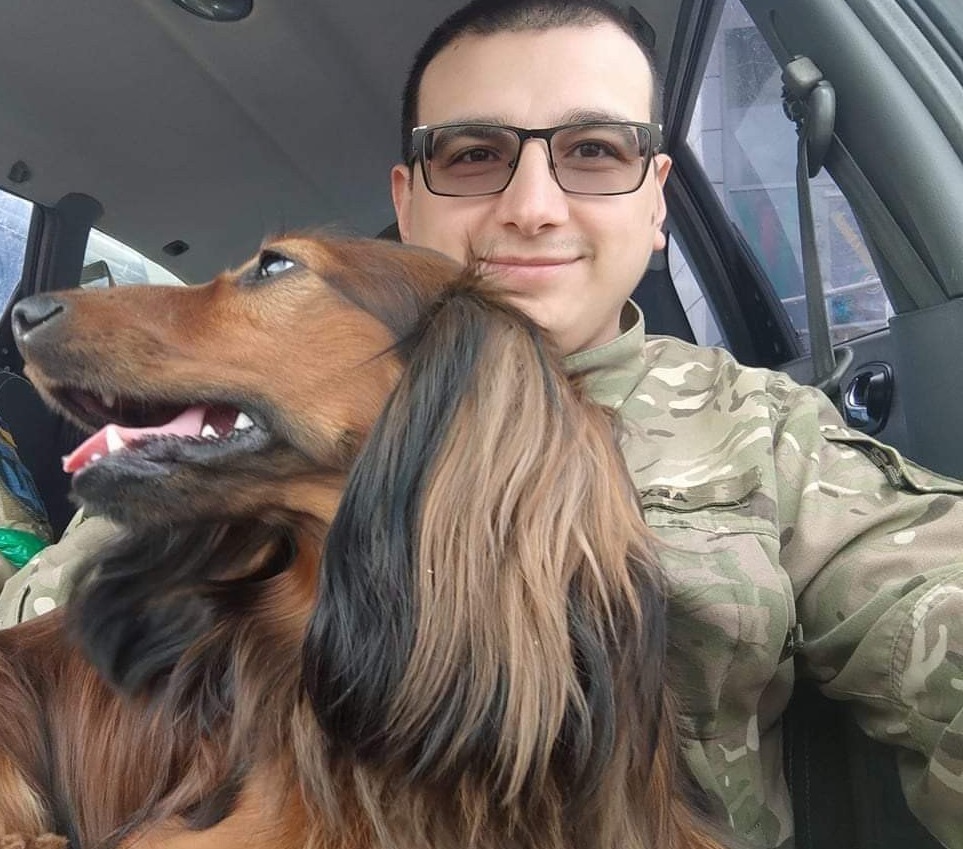
Astamur Gumba
Considering the pro-Russian allegiance of ethnic Abkhazians during the Russian-Ukrainian war, the personality of Astamur Gumba stands alone. Astamur Gumba was an ethnic Abkhazian, born in Sokhumi in 1989, who fought in the AFU. Gumba, nicknamed “Abkhaz”, served in the 130th Battalion of the 112th Independent Brigade of the Territorial Defence Forces in Kyiv. In 1992, Gumba’s family fled Abkhazia to move to Ukraine. In 2011, Gumba graduated from the Faculty of Philosophy of Kyiv National University. Despite living in Ukraine for 29 years, Astamur Gumba did not have Ukrainian citizenship.
In February 2022, Astamur Gumba joined the AFU. During the full-scale Russian invasion, Gumba participated in the defence of Kyiv and later of Kharkiv Oblast. Astamur Gumba perished in June 2022 near Dementiivka, Kharkiv Oblast. By Decree of the President of Ukraine, Astamur Gumba was awarded the “Order for Courage” of the Third Class, posthumously. In his memory, Astamur’s mother announced the establishment of the Astamur Gumba Peace Foundation, which will focus on conflict research in Southeast and Eastern Europe.
Conclusion
Abkhazia and “South Ossetia” are militarily involved in the Russian temporary occupation of Ukrainian territories since its beginning in 2014. Although the influence of their involvement is negligible, practically and symbolically, Abkhazia and “South Ossetia” stand out as accomplices to Russia’s military effort and war crimes in Ukraine. Considering their complete reliance on Russian financing and military occupation, the quasi-republics’ motivation to participate in Russia’s aggression lies in the belief that their future fully depends on Russia’s positioning on the global political stage as a result of the Russian-Ukrainian war.
“South Ossetia” was more active in terms of supporting Russia’s military effort in Ukraine. South Ossetian mercenaries fighting for Russia against Ukraine have been part of different formations since 2014. The former de-facto president of “South Ossetia” Anatoliy Bibilov, after coming to power in 2017, increased South Ossetian military activity in the temporarily occupied parts of the Donbas. Under his de-facto rule, the South Ossetian de-facto army was merged with the Russian military contingent of the 4th military base, located in the temporarily occupied Tskhinvali district of Georgia. When Russia launched its full-scale invasion of Ukraine in 2022, the 4th military base was soon called up to participate in Russia’s full-scale military aggression, and South Ossetian servicemen were sent to fight as well. This led to a political scandal in the Tskhinvali region, resulting in hundreds of servicemen unilaterally returning from the frontlines at the end of March 2022. As of June 2023, Ossetians from the Tskhinvali region are fighting on the Zaporizhzhia front, the potential location of the main axis of Ukraine’s summer counteroffensive operations, as part of ethnic Ossetian battalions. Allegedly, these military formations are suffering heavy losses.
Regarding Abkhazia, the “Pyatnashka” brigade is notable as a mercenary formation founded by ethnic Abkhazians in 2014 to participate in the occupation of parts of the Donbas. “Pyatnashka” is known to have engaged in crimes against the civilian population. As of 2023, the brigade is formally integrated into the Russian Armed Forces and continues to participate in the Russian aggression mainly in the Avdiivka direction. However, Abkhazia has not sent a single quasi-official military unit to Ukraine and refused to participate in the Russian “partial mobilisation”.
The number of confirmed casualties among the Tskhinvali region’s natives is higher than that of Abkhazians, probably due to the merger of the South Ossetian de-facto army with the Russian Armed Forces and consequent direct participation in the full-scale Russian invasion of Ukraine. The real number of sustained casualties of both Abkhazians and Ossetians from the Tskhinvali region is likely to be higher.

